General Information
Benchmark Instructional Guide
Connecting Benchmarks/Horizontal Alignment
Terms from the K-12 Glossary
- Circle
- Rectangle
Vertical Alignment
Previous Benchmarks
Next Benchmarks
Purpose and Instructional Strategies
The purpose of this benchmark is to introduce the initial idea of equal parts in the form of halves and fourths. While students are not expected to use a numerator or denominator, it is the first exposure for students to see circles and rectangles partitioned into two or four equal-sized parts which sets the stage for fractional understanding. In Kindergarten, students recognized how combining two equal-sized triangles can form a rectangle. Also in Kindergarten, students learned that whole numbers up to 10 could be broken apart into two other whole numbers (MTR.5.1).- Instruction includes the idea of part-whole relationships as supported by the model (MTR.5.1).
- Instruction includes naming the parts based on the number of equal parts that make the whole.
- Instruction includes partitioning rectangles in multiple ways, such as horizontal, vertical, and diagonal, to show halves or fourths. Depending on the type of rectangle that is being presented, it may not result in four equal parts (MTR.2.1).
Common Misconceptions or Errors
- Students may have difficulty partitioning circles or rectangles into equal-sized parts; additional guided practice may be helpful in these cases.
- When a rectangle is divided into fourths using its diagonals students may have trouble seeing that all four parts are the same size. This should not be a point of contention, but it should be an opportunity to explain to students that they will get a deeper understanding of this in later grades.
Strategies to Support Tiered Instruction
- Teacher models partitioning circles and rectangles into fourths using a geoboard to investigate equal-sized parts.
- Example:
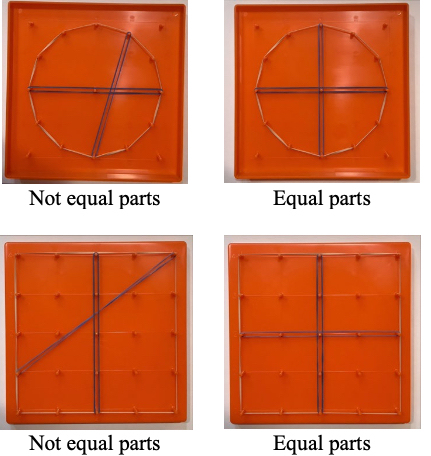
- Teacher models folding rectangles and circles into halves and fourths to develop an understanding of equal sized parts.
- Instruction provides opportunities to investigate equal sized parts using paper squares
divided into fourths on the diagonal.
- For example, teacher provides paper squares and demonstrates how to divide it into fourths on the diagonal. Discussion should be centered on recognizing parts that are equal by folding the paper over onto itself to show the parts are equal.
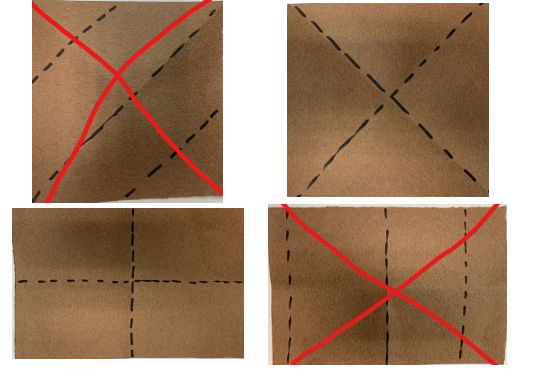
Instructional Tasks
Instructional Task 1 (MTR.2.1, MTR.4.1)
Part A. Partition the circles and rectangles in different ways to show two equal parts. Name the parts of the whole.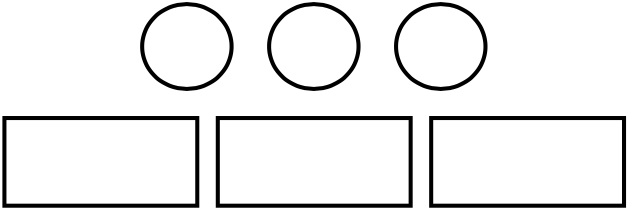
- My shapes are partitioned into ________________________.
- Compare with a partner to discuss if your circles and rectangles look alike and share how you know your shapes show two equal parts.

- My shapes are partitioned into ________________________.
- Compare with a partner to discuss if your circles and rectangles look alike and share how you know your shapes show four equal parts.
Instructional Task 2 (MTR.4.1)
Josephine says she partitioned the clocks below into halves. Do you agree with her? Why or Why not?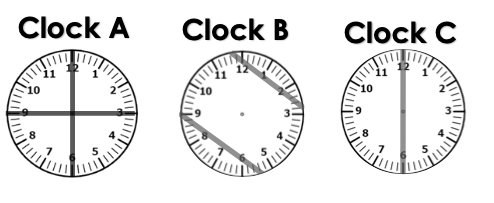
Enrichment Task 1
Repeat Instructional Task 2 with halves replaced by fourths; helps makes the connection to grade 2.
Instructional Items
Instructional Item 1
Divide a piece of paper into two parts so that each part has an equal amount. How could you describe each part?
Instructional Item 2
Pretend each of the circles below is a cake.- The first one is for two people. Can you show how you would partition the cake for 2? This cake is partitioned into _________.
- The second cake is for 4 people. Can you show how you would partition the cake for 4? This cake is partitioned into _________.
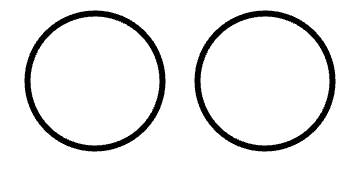
*The strategies, tasks and items included in the B1G-M are examples and should not be considered comprehensive.
